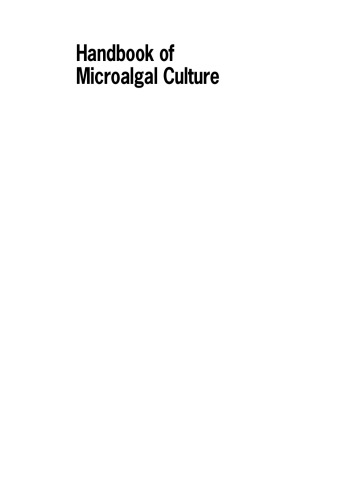Product desciption
Handbook Of Microalgal Culture Biotechnology And Applied Phycology Amos Richmond by Amos Richmond 9780470995280, 9781405128322, 0470995289, 1405128321 instant download after payment.
Handbook of Microalgal Culture is truly a landmark publication, drawing on some 50 years of worldwide experience in microalgal mass culture. This important book comprises comprehensive reviews of the current available information on microalgal culture, written by 40 contributing authors from around the globe. The book is divided into four parts, with Part I detailing biological and environmental aspects of microalgae with reference to microalgal biotechnology and Part II looking in depth at major theories and techniques of mass cultivation. Part III comprises chapters on the economic applications of microalgae, including coverage of industrial production, the use of microalgae in human and animal nutrition and in aquaculture, in nitrogen fixation, hydrogen and methane production, and in bioremediation of polluted water. Finally, Part IV looks at new frontiers and includes chapters on genetic engineering, microalgae as platforms for recombinant proteins, bioactive chemicals, heterotrophic production, microalgae as gene-delivery systems for expressing mosquitocidal toxins and the enhancement of marine productivity for climate stabilization and food security.; Handbook of Microalgal Culture is an essential purchase for all phycologists and also those researching aquatic systems, aquaculture and plant sciences. There is also much of great use to researchers and those involved in product formulation within pharmaceutical, nutrition and food companies. Libraries in all universities and research establishments teaching and researching in chemistry, biological and pharmaceutical sciences, food sciences and nutrition, and aquaculture will need copies of this book on their shelves. Amos Richmond is at the Blaustein Institute for Desert Research, Ben-Gurion University of the Negev, Israel.
Content: Cover --
Table of Contents --
List of Contributors --
Preface --
Acknowledgments --
Part I: The Microalgae: With Reference to Mass-Cultivation --
1 The Microalgal Cell --
2 Photosynthesis in Microalgae --
3 Basic Culturing Techniques --
4 Environmental Stress Physiology --
5 Environmental Effects on Cell Composition --
Part II: Mass Cultivation of Microalgae --
6 Algal Nutrition: Mineral Nutrition --
7 Algal Nutrition: Heterotrophic Carbon Nutrition --
8 Biological Principles of Mass Cultivation --
9 Mass Production of Microalgae: Photobioreactors --
10 Downstream Processing of Cell-mass and Products --
Part III: Economic Applications of Microalgae --
11 Industrial Production of Microalgal Cell-mass and Secondary Products ... Major Industrial Species: Chlorella --
12 Industrial Production of Microalgal Cell-mass and Secondary Products ... Major Industrial Species: Arthrospora (Spirulina) platensis --
13 Industrial Production of Microalgal Cell-mass and Secondary Products ... Major Industrial Species: Dunaliella --
14 Industrial Production of Microalgal Cell-mass and Secondary Products ... Species of High Potential: Haematococcus --
15 Industrial Production of Microalgal Cell-mass and Secondary Products ... Species of High Potential: Porphyridium sp. --
16 Industrial Production of Microalgal Cell-mass and Secondary Products ... Species of High Potential: Mass Cultivation of Nannochloropsis in Closed Systems --
17 Industrial Production of Microalgal Cell-mass and Secondary Products ... Species of High Potential: Nostoc --
18 Microalgae in Human and Animal Nutrition --
19 Microalgae for Aquaculture: The Current Global Situation and Future Trends --
20 Microalgae for Aquaculture: Microalgae Production for Aquaculture --
21 Microalgae for Aquaculture: The Nutritional Value of Microalgae for Aquaculture --
22 N[sub(2)]-fixing Cyanobacteria as Biofertilizers in Rice Fields --
23 Hydrogen and Methane Production by Microalgae --
24 Water Pollution and Bioremediation by Microalgae: Eutrophication and Water Poisoning --
25 Water Pollution and Bioremediation by Microalgae: Water Purification: Algae in Wastewater Oxidation Ponds --
26 Water Pollution and Bioremediation by Microalgae: Absorption and Adsorption of Heavy Metals by Microalgae --
27 Water Pollution and Bioremediation by Microalgae: Impacts of Microalgae on the Quality of Drinking Water --
Part IV: New Frontiers --
28 Targeted Genetic Modification of Cyanobacteria: New Biotechnological Applications --
29 Microalgae as Platforms for Recombinant Proteins --
30 Bioactive Chemicals in Microalgae --
31 Heterotrophic Production of Marine Algae for Aquaculture --
32 N[sub(2)]-fixing Cyanobacteria as a Gene Delivery System for Expressing Mosquitocidal Toxins of Bacillus thuringiensis subsp. israelensis --
33 The Enhancement of Marine Productivity for Climate Stabilization and Food Security.
Abstract: Handbook of Microalgal Culture is truly a landmark publication, drawing on some 50 years of worldwide experience in microalgal mass culture. This important book comprises comprehensive reviews of the current available information on microalgal culture, written by 40 contributing authors from around the globe. The book is divided into four parts, with Part I detailing biological and environmental aspects of microalgae with reference to microalgal biotechnology and Part II looking in depth at major theories and techniques of mass cultivation. Part III comprises chapters on the economic applications of microalgae, including coverage of industrial production, the use of microalgae in human and animal nutrition and in aquaculture, in nitrogen fixation, hydrogen and methane production, and in bioremediation of polluted water. Finally, Part IV looks at new frontiers and includes chapters on genetic engineering, microalgae as platforms for recombinant proteins, bioactive chemicals, heterotrophic production, microalgae as gene-delivery systems for expressing mosquitocidal toxins and the enhancement of marine productivity for climate stabilization and food security.; Handbook of Microalgal Culture is an essential purchase for all phycologists and also those researching aquatic systems, aquaculture and plant sciences. There is also much of great use to researchers and those involved in product formulation within pharmaceutical, nutrition and food companies. Libraries in all universities and research establishments teaching and researching in chemistry, biological and pharmaceutical sciences, food sciences and nutrition, and aquaculture will need copies of this book on their shelves. Amos Richmond is at the Blaustein Institute for Desert Research, Ben-Gurion University of the Negev, Israel


